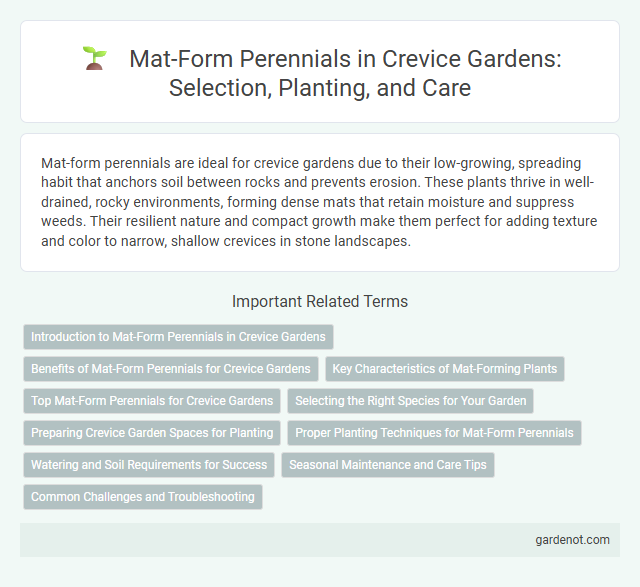Mat-form perennials are ideal for crevice gardens due to their low-growing, spreading habit that anchors soil between rocks and prevents erosion. These plants thrive in well-drained, rocky environments, forming dense mats that retain moisture and suppress weeds. Their resilient nature and compact growth make them perfect for adding texture and color to narrow, shallow crevices in stone landscapes.
Introduction to Mat-Form Perennials in Crevice Gardens
Mat-form perennials are key components in crevice gardens, valued for their low-growing, spreading habit that efficiently covers soil and suppresses weeds. These plants thrive in the narrow, rocky fissures of crevice gardens, where their dense mats help retain moisture and provide erosion control. Species such as creeping thyme (Thymus serpyllum) and sedums (Sedum spp.) demonstrate excellent adaptability to well-drained, nutrient-poor conditions characteristic of crevice garden environments.
Benefits of Mat-Form Perennials for Crevice Gardens
Mat-form perennials, such as creeping thyme and sedum, offer excellent ground coverage for crevice gardens, reducing soil erosion and moisture loss. Their low-growing habit and drought tolerance make them ideal for thriving in narrow, shallow planting spaces with minimal maintenance. These plants also enhance biodiversity by providing habitat and nectar sources for pollinators within the unique microenvironment of crevice gardens.
Key Characteristics of Mat-Forming Plants
Mat-forming perennials exhibit a dense, low-growing habit that effectively covers ground while suppressing weeds and minimizing soil erosion. These plants spread via stolons or rhizomes, creating a carpet-like texture ideal for filling crevice gardens' shallow, rocky substrates. Their drought tolerance and ability to thrive in poor soils make them essential for sustainable, maintenance-light garden designs.
Top Mat-Form Perennials for Crevice Gardens
Top mat-form perennials for crevice gardens include Thymus serpyllum (Creeping Thyme), known for its aromatic foliage and vibrant pink flowers that attract pollinators. Dianthus deltoides (Maiden Pink) offers low-growing, colorful blooms ideal for tight stone gaps, enhancing both texture and color. Sedum spurium (Caucasian Stonecrop) features succulent leaves with a spreading habit, providing drought tolerance and year-round interest in rock-filled crevices.
Selecting the Right Species for Your Garden
Selecting the right mat-form perennial species for your crevice garden ensures optimal ground coverage and vibrant seasonal interest. Low-growing varieties such as Sedum acre, Thymus serpyllum, and Saxifraga arendsii thrive in shallow soil crevices, offering drought tolerance and colorful blooms. Consider growth habit, light requirements, and local climate adaptability when choosing species to create a durable, visually appealing mat-form plant layer.
Preparing Crevice Garden Spaces for Planting
Mat-form perennials thrive in well-prepared crevice garden spaces that mimic their natural rocky habitats. Creating narrow, angular gaps between stones enhances drainage and allows roots to spread evenly, promoting healthy growth. Using a gritty, well-draining soil mix rich in organic matter ensures optimal moisture retention without waterlogging.
Proper Planting Techniques for Mat-Form Perennials
Proper planting techniques for mat-form perennials in crevice gardens involve selecting well-draining soil and ensuring adequate sunlight exposure to promote healthy growth. Planting should be done at the same soil depth as the nursery container to prevent root rot and encourage stable mat formation. Regular spacing and minimal disturbance during planting allow the perennials to establish strong root networks essential for ground coverage and erosion control.
Watering and Soil Requirements for Success
Mat-form perennials thrive best in well-drained, sandy or rocky soils that mimic their natural crevice garden habitat. Consistent but moderate watering is essential, ensuring soil remains moist without becoming waterlogged to prevent root rot. Proper soil preparation with added grit or sand improves drainage, promoting healthy root development and long-term growth success.
Seasonal Maintenance and Care Tips
Mat-form perennials in crevice gardens require regular seasonal maintenance to thrive, including removing dead foliage in early spring to encourage new growth and prevent disease. During summer, light watering is essential to keep the soil moist but well-drained, while avoiding overwatering to prevent root rot. In autumn, cutting back to ground level helps the plants conserve energy for winter dormancy and prepares them for vigorous growth in the following season.
Common Challenges and Troubleshooting
Mat-form perennials in crevice gardens often face challenges such as poor drainage and root rot due to water accumulation in narrow gaps. Inadequate sunlight can lead to weak growth and reduced ground cover density, hindering their mat-forming habit. Ensuring proper soil composition with high mineral content and strategic placement in sun-exposed crevices helps prevent common growth issues and promotes healthy proliferation.
Mat-form perennial Infographic

 gardenot.com
gardenot.com